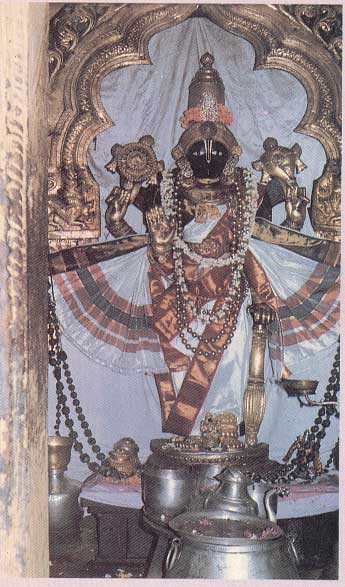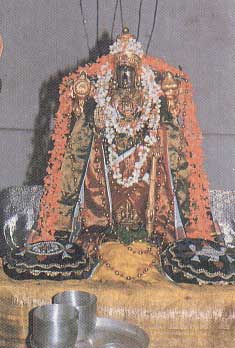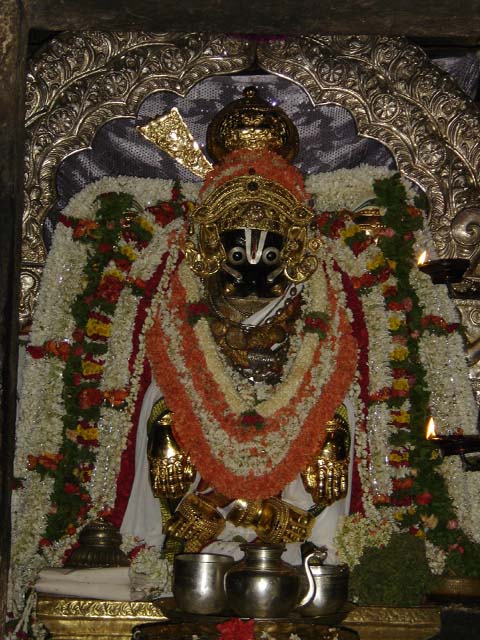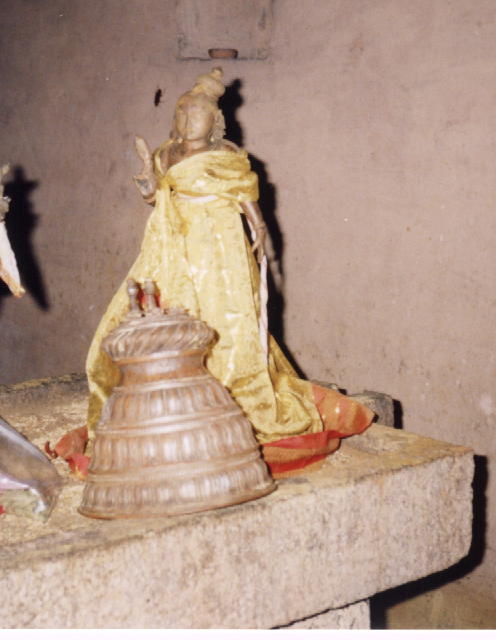We are in Melkote, the Empire of Sri Thirunarayana Perumal. It is in Karnataka state. From Bangalore, either via Nagamangala or via Mandya, Mysore, we can reach this
Kshetram. From Mysore it is about an hour's journey. It is situated on Yadagiri or Yathusailam. Surrounding nature is beautiful. It is called Melkote, because kings used to build forts on the hill here and reigned and so
Mel [above]
kote [fort]. Also it was the Western side fort and so
Mel [short form for
merku, west in Tamil]. Since the Lord is Sri Thirunarayanan, this place has the name THirunarayanapuram. From lord Brahma to Sanathkumara, then Sri Dattatreya, then Sri Balarama and Sri Krishna, have worshiped the deity here. The Lord here was established by Sanathkumara. After very long time, this place got submerged in earth and was hidden. The Lord was thus lost from sight. Like He is hidden in everyone of us, the Lord remained hidden under the earth. In
Kali yug, the Lord was not visible to all, for some years.
Swami Ramanuja brought oue the Lord to the outside world, for the benefit of all.
Swami Ramanuja was living in Srirangam. Once the King there, Kirumikanda Chola [கிருமி கண்ட சோழன் ], out of hatred for
Vaishnavam, wanted to punish
Swami Ramanuja.
Swami Koorathalwan, decided to save
Swami Ramanuja.
Swami Ramanuja was an ascetic with safron robes; while
Swami Koorathalwan was domestic and had white robes.
Swami Koorathalwan tricked by exchanging the robes, and sent
Swami Ramanuja with white robes, in the West direction.
Swami Ramanuja along with
Swami Mudaliyandan [முதலியாண்டான் ] and other disciples, reached Karnataka. Travelling along river
Kaveri, and crossing Sathyamangalam forests, they reached Thondanur, in Karnataka. He lived in Thondanur for quite some time. Thondanur has a very big lake.
 THONDANUR LAKE
THONDANUR LAKEDuring his stay, once the thiruman [திருமண்], used to paint on the forehead, was exhausted. Normally, this is available from earth. Painting Namam [நாமம் ], on the forehead is an identity for
Sri Vaishnavites and it represented the Divine feet of the Lord. Without
thiruman,
Swami Ramanuja was veru much worried and he remained on fasting for three days. At that time Sri Thirunarayana
Perumal appeared in the dream of
Swami Ramanuja; and ordained him to come up the hill Yadavagiri, where the Lord would provide him
thiruman and also show the location where the Lord was hiding, under the Earth. When
Swami Ramanuja tried to climb, he found the hill was very steep. Earlier, the King of the place Bittaraya Deva, had become the disciple of
Swami Ramanuja, who had rechristened him as King Vishnuvardhana. With his help
Swami Ramanuja was able to reach Melkote. First comes
Vedadri Pushkarini, near which is
Datatreya Theertham. Here, Sri Dattatreya recieved safron robe and kamandalam, to become an ascetic.
Swami Ramanuja also again took safron robes here. It happened on
Thai [தை ] month Punarvasu star day. Even today, grand festival is celebrated on that day here. He found
thiruman nearby and was pleased to decorate himself with the twelve
namams. Then he searched for the Lord. Here also the Lord showed him the way by asking him to go along the route of
Thulasi plants. He reached in the present location of the
garbhagruha. When he dug the earth, there he found the Lord, to the immense happiness of
Swami Ramanuja. Immediately
Swami Ramanuja remembered the First
pasuram of 4.1
Thiruvalmozhi of Nammalwar [
Oru Nayagamai oda ulagudaiya andavar...Thirunaranan thal kalanpera chinthithu uymino] [ஒரு நாயகமாய் ஓட உலகுடன் ஆண்டவர் .....திரு நாரணன் தாள் காலம் பெறச் சிந்தித்து உய்ம்மினோ] and dedicated that
pasuram for the Lord here. People run after wealth and property, little realizing they are transient. Only the divine feet of Sri Thirunarayanan is our permanent wealth and so cling to them, advises Nammalwar. Earlier it was told that in Mannargudi,
Swami Manavala Mamunigal dedicated the
pasuram, unnitthu matroru deivam thozhal [உன்னித்து மற்றொரு தைவம் தொழாள் ], to Sri Rajagopala
Perumal there. Here,
Swami Ramanuja dedicated
Oru nayagamai pasuram to Sri Thirunarayanan
Perumal. Thirunaranan thal in the
pasuram indicates the Divine feet of Sri Thirunarayanan.
Sri Nachiyar is seated between the Divine feet of the Lord here. So, the feet are associated with
Sri Thayar. Nammalwar calls upon all of us to cling to these feet, to get redeemed. After taking out the Lord,
Swami Ramanuja installed the deity same day. Thus the Lord got established here again. Thus
Thai Punarvasu is celebrated veru enthusiastically here. Like Sri Varaha brought out Sri Bhudevi,
Swami Ramanuja brought out the Lord here. In the
sloka 20 of Chapter 10, the Lord tells Arjuna that He is dwelling in each and every thing in this Universe; but only a few realize this. He is residing in our hearts. But how many realize this?
Swami Ramanuja was needed to bring out the hidden Lord. There the Lord was in idol form so it could be seen by us; but to realize the Lord in our heart is very difficult. In
sloka 19, the Lord told that He would list out the more important of His wealth. Now
sloka 20:
aham atma gudakesha
sarva-bhutasaya-sthitah
aham adis ca madhyam ca
bhutanam anta eva ca
"I am the Supersoul, O Arjuna, seated in the hearts of all living entities. I am the beginning, the middle and the end of all beings."
Each line of the verse gives a meaning. He tells Arjuna that all the things he perceives are all His property. It is not like what we possess property. If we have money we can keep it in lockers or in our briefcase, remembering that money is physically different and separate form us. But the property of the Lord is not like that. They are always associated with Him as an integral part. All of them are His body. When atman resides in a body, it gets a name and is identified. Atman as such has no name but when it is in a body, the body gets a name and atman also is recognized with that name, as long as it is in that body. If we call a person, he turns. Though the name is for the body, without the command of atman, the body will not turn. In a similar way, the Lord is the atman in everything. He is residing in our atman as antharatman and is residing also in the body as atman. Thus all atman are the body of the Lord; also, all the materials are His body. Aham = I [ Sri Krishna] am, atma = the antharathma or inner soul, gudakesha = vanquisher of sleep [Arjuna]. Gudaka means sleep, isha means commander. Sarva bhuta = in every living beings, asaya =hearts, sthitha = established or dwelling. Our body obeys our commands,and so our body is our property. Like this, He is the inner atman in every atman or living beings and so all are His property. All are to obey His commands. This is called sareera-atma bhava or the relationship of He being soul and all His body. In the next line He says the cause-effect relationship. Mud is cause and pot is effect. Gold is cause and ornaments are effects. Similarly, the Lord is the Cause and all others are effects. Aham = I [Sri Krishna] am, adi = Cause for creation, madhyam ca = also the sustainer or protector of all created, anta eva ca = even the end at the time of Pralayam , bhutanam = of all living beings. He is the Cause for creation, sustaining and destruction, of all. This is called karana-karya bhava or cause-effect relationship. He is the supporter. He is the Commander. He is the proprietor. He is the Leader. Nothing is not in His control or ownership. If we clearly understand this, then it would be easier to understand the list He is going to deliver from sloka 21 to sloka 39.






